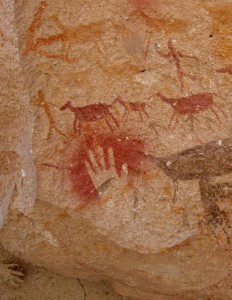
Technology and humanity go way back. Technology was there at our dawn, in sharp rocks and bone needles, in cave paintings and figurative sculpture. It’s an old trope that technology is what makes us human, that tools and language are what first set us apart from other animals. Now, however, as technology is beginning to reach human developmental milestones, such as tracking faces and recognizing speech, a growing number of people think that technology is alive. While I’m one of them, I think the idea of technology as a life form is just the beginning of the story. Beyond the superficial similarities between technology and life, there lies a deeper truth about technology and information. This truth goes straight to the heart of our future on this planet and our evolving relationship with technology. This is an old relationship indeed, so let’s begin with an old myth about technology.
According to medieval Jewish legends, a rabbi made a golem, a man shaped from clay, to do the rabbi’s bidding and protect the Jewish community. The golem was inert and lifeless until brought to consciousness by words, just as Adam was in the Book of Genesis. Different versions of the myth describe the rabbi speaking the words, writing them on parchment and placing them in the golem’s mouth, or inscribing them on the clay man’s forehead. This tale of crossing the divide between the inert and the living has resonance in the context of modern technology and information. Today the distinction between the made and the born is dissolving, and information is the solvent.
The most important link between technology and life is that both are manifestations of information. What do I mean by information? It has been described by others as a signal, a dis-ordering, a difference that makes a difference. James Gleick has struggled admirably with this question in The Information, but the simplest definition is by example. There is information encoded in the rocks of the earth and in the pages of a book, if you know how to read it. There is information in the DNA in every cell of my body, and in my body itself. My height and my fine teeth carry information about the privileged world I grew up in, just as my mother’s numerous fillings speak of the dental care available to her in the rural poverty of her childhood.
In the case of biological life, deciphering the role of information took centuries to achieve. As we now understand it, biological life is devoted to transmitting genetic code, recorded in the chemical sequences of our DNA. This simple process of information transmission has given rise to an astounding array of life forms and phenomena over the course of billions of years. Yet at root, the whole enterprise is devoted to passing on a message.
Information can be found wherever the physical world is organized into meaningful patterns. For example, a hammer’s form contains information about where it was made, its intended uses, the age of the tree that became the wooden handle, and even the size of the beings meant to wield it. But there is a deeper level of information: the hammer is an organization of materials which take advantage of basic properties of the universe for a distinct purpose. In the case of a hammer, the physical properties of mass, hardness, and leverage are all used in the service of pounding something.

By organizing materials in the physical world, each technology opens up new possibilities, on its own and in combination with other technologies. These possibilities may even include new technologies that were impossible or impractical before. For example, the development of steel girders and safe elevators made a new building technology, the skyscraper, both possible and practical. As technologies multiply, the possible combinations grow exponentially. This is the mechanism that W. Brian Arthur brilliantly describes in his exploration of the origins of new technologies in The Nature of Technology. Amazingly, this is also an excellent description of the basis of biological life; the organization of chemicals into genetic code and physical forms for the ongoing purpose of self-perpetuation.
The technological world, as we think of it, is much younger than the biological one. The systematic study of technology is younger still, dating only to the middle of the twentieth century. As a subject of study, technology pales next to the complexity of biology. A washing machine is less complex than an amoeba by many orders of magnitude, and has a life that is necessarily constrained. (You may be thinking, “Life of a washing machine?” This is just the sort of question I want you to be asking.) And of course a washing machine does not reproduce itself, and a good thing, too. The last thing we need is a gaggle of tiny washers scurrying around the basement. However, just as a microscope can reveal the teeming life in a droplet of water, a theory of living technology illuminates the true nature of the mechanical beasts that surround us.
Like biological life, technology eludes our observation in its scale and mode of reproduction. A washing machine does not reproduce itself, but neither does a red blood cell. The cell is reliant on the rest of the body for its existence and replenishment. To view the technological system from a similar scale would require us to take in all the factories, mines, oil wells, engineers and engines on the planet. Considered from this perspective, technology is in a state of constant reproduction. Every tool I can see from where I now sit was made, and made possible, by another tool. This view of the technological world as an ecosystem or superorganism is no mere analogy, but rather a recognizable manifestation of the underlying properties of information.
In this space, I intend to explore the story of living technology. This story encompasses the grand arc of history, from the beginnings of the universe to the first stirrings of human societies, and on to the rapidly unfolding present. Seeing technology and life as intertwined provides a shift in perspective, one which sheds new light on topics as diverse as the myth of lone invention, the goal of full unemployment, the moral crisis of climate change, and the underpinnings of our economic and social order. This shift in perspective can’t come quickly enough. Whereas biological evolution has proceeded slowly across countless generations, it is clear today that technological change proceeds at an accelerating pace.
The golem continues to be an apt analogy, not just as a technology but as an information technology. Breathing words into a construction led not only to life, but to intelligence. As with the golem, this intelligence can be a source of tremendous power and protection, but may also sow the seeds of chaos and disruption. People imagine an alien intelligence coming down to us from the stars on a flying saucer, and take for granted the distributed intelligence in the libraries and computers all around them. E.T. shows no signs of appearing, but our first contact with an alien intelligence has already occurred, and it is an intelligence that we ourselves have created.
the goal of full unemployment…This reminds me of hot economics discussions in the early 1960’s. Economists and social scientists (like Paul Goodman and others) were concerned about the forced leisure that automation of production processes produced. Of course, the “forced leisure” that resulted turned out to be unemployment or low level employment, rather than the enrichment of life that the progressive thinkers had imagined.
But one exception to the new leisure was in the scientist-entrepreneur-art collector Dr. Albert Barnes’s actions. discovering that his factory workers could do their work in only six hours of their eight-hour day, he provided art education and appreciation courses in those extra two hours. These courses became the basis of a highly successful and well-regarded effort for the public at all levels of society.
Yes, it seems like every gain in productivity was once championed as a key to more leisure, when instead the world seems to keep speeding up. If we see the automation of intellectual work as a boon, we should be cautioned by the history of automation of physical labor, which has had decidedly mixed results for those on the receiving end of the machines. We can do more with less, but the rewards are unevenly distributed.